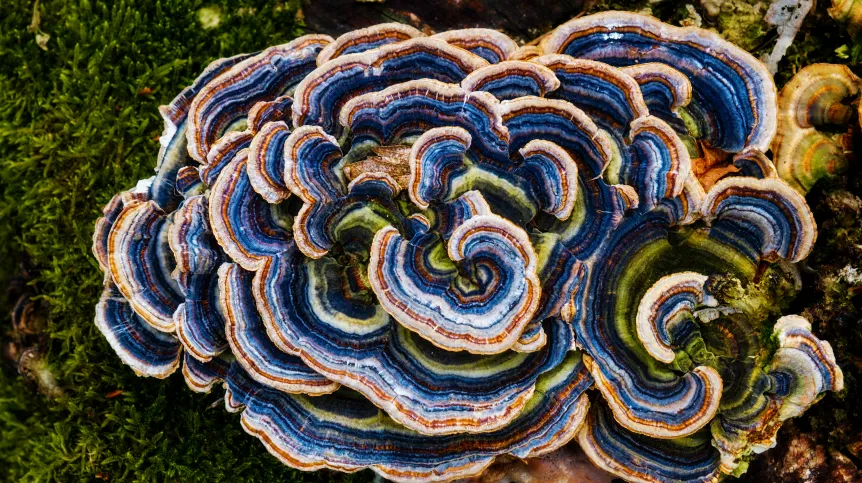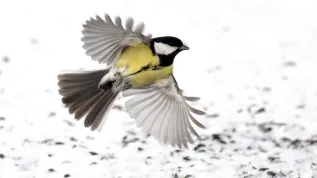
Fungi and humans come from a common ancestor, something like an amoeba or a slime mould. They also communicate, move, have sex, fight, and can be dangerous, say mycologist Dr. Marta Wrzosek.
Dr. Wrzosek is a biologist and mycologist at the University of Warsaw, an employee of the botanical garden and lecturer at the Faculty of Biology of the University of Warsaw.
PAP: What are fungi, because to me they seem to be organisms in between. Neither animal nor plant.
Marta Wrzosek: Not exactly in between, because fungi are much more closely related to animals than to plants. Fungi and animals share a common ancestor, which probably looked like an amoeba, and plants are very, very far from it. The two largest groups of organisms in the world are fungi and animals. The number of species of animals is the highest thanks to the countless species of insects, and the second largest group in terms of species are fungi. There are many more of them than plants, which are phylogenetically distant from them, meaning they form an independent branch on the tree of life.
PAP: Are you suggesting that we come from a fungus?
M.W.: No, from something like an amoeba or a slime mould, which was a heterotrophic amoeba. It moved using pseudopodia, probably also had a pushing flagellum for rapid movement, and devoured everything in its path. Two large phylogenetic lines emerged from such an amoeba - one towards fungi, the other towards animals.
What distinguishes animals from fungi the most is the cell wall - in the developmental line leading to fungi, the amoeba began to produce cell walls, while in the second, animal line, only cell membranes remained. The cell wall is useful in that it protects the cell from stressful conditions, but it also has its drawbacks. A cell enclosed by a wall can no longer devour what it finds on its way. It can only absorb small particles in an aqueous solution. It can also secrete enzymes that externally decompose what will be absorbed after a while.
PAP: So fungi have cell walls, and we have cell membranes.
M.W.: Yes, that is the basic difference between us and fungi. However, the reserve materials in fungi and animals are the same. Firstly, it is fat, and secondly, glycogen, a polysaccharide that we store in the liver. Although fungi do not have a liver, they store glycogen in fimbriae in the form of small vesicles that look like grains of sand.
PAP: But unlike us, fungi do not move.
M.W.: That is not true. A large part of fungi move, and some of them do it very well. Especially fungi belonging to old evolutionary lines. Some produce cell walls only at certain stages of their life, and at other stages they maintain the amoeba stage, which means they can move independently by stretching out their pseudopodia. This most often happens in the cells of other organisms. Others dart quickly through the water or soil solution thanks to their whip-like flagella. They resemble sperm in appearance. Few people know about them, but this is quite a diverse group of organisms. We can find them in every pond, in every lake, and sometimes even in a puddle.
PAP: Fungi also live in salt water.
M.W.: One of the oldest groups of fungi are Cryptomycota, also called Rozellomycota. The first name suggests that they are hidden fungi. When researchers first identified the first organism from this group, with the genus name Rozella, 13 years ago, they realized that they were looking at a fungus unlike any other. When the DNA of this organism was compared to 'environmental DNA', i.e. DNA obtained from soil, water or air, it turned out that this organism and organisms related to it are found in soil solution, in estuaries, i.e. river mouths, in lakes, in oceans.
They are everywhere, and we still hardly know them. A few months ago, we received the results of genetic tests that showed us what was found in the so-called cheek pockets of wood ants - and there even we found representatives of Cryptomycota.
PAP: New species of fungi are still being discovered.
M.W.: Not a year goes by without Polish teams of mycologists having to describe new species. You do not have to go to tropical forests. We find them in Poland, too.
PAP: I will ask about another, seemingly obvious, difference between people and fungi. People communicate, do fungi communicate as well?
M.W.: Yes, they communicate through chemical signals, there is no doubt about that. This can be determined by observing the sexual behaviour of fungi - by the way, some species have two sexes, while others have four. In any case, fungi send and receive chemical signals to find sexual partners. This is how they find each other.
A fungal hypha, which develops somewhere in the substrate, secretes a volatile substance that informs about its gender and location. It is received by a partner hypha, which itself secretes information about itself. And then they slowly begin to move towards each other. It is a dialogue in which chemical molecules play the role of words. They are sent and received.
PAP: So there is a bolete-girl and a bolete-boy.
M.W.: Not exactly, because bolete is in a sense hermaphroditic. The sexual process in many fungi is quite complicated. It starts early and ends late. I tell my students that it is like a very prolonged sexual intercourse. Boletes, already at the hyphal stage, are two connected sexes, which, however, only join their nuclei under the cap, even though they have been connected to each other for years. Not only are they intertwined, but they really are one body.
PAP: How is it possible that some fungi have as many as four sexes?
M.W.: Four sexes can be evolutionarily advantageous under certain conditions. In cities, we often encounter a fungus called Schizophyllum commune. DNA studies show that it also has four different sex types. The downside is that it is more difficult for them to find a suitable partner. The advantage is that the 'children' of these fungi are genetically more diverse than in two-sex species.
Fungi that we call homothallic produce offspring without a partner. It happens that if a fungus finds itself in an environment very rich in nutrients, which is also safe and unchanging, it gives up sexual reproduction so as not to bother with finding a partner and to grow as quickly as possible.
PAP: Can fungi defend themselves? Fight?
M.W.: Yes, absolutely. It is common knowledge that some fungi produce penicillin, right? Of course, they do not produce it for humans to protect them from bacteria, but to protect themselves, and we simply steal it from them.
The second weapon of fungi is their cell walls. It is harder to pierce plywood with a pin than a thin balloon wall. Similarly, it is harder for bacteria and other fungi to penetrate a cell wall - especially if it is thick, stiff and saturated with melanin.
Fungi also produce chemicals that are toxins - they do not hunt humans, but deter other organisms that could harm them. The most dangerous mushroom for humans is Amanita phalloides, also known as the death cap. One cap is enough to kill an adult human. This mushroom does not harm snails and they eat it willingly. But they spread death cap spores, so it doesn't defend itself against them - but those who threaten it should beware.
PAP: Fungi are also great conquerors, one individual can take over dozens of square kilometers of forest.
M.W.: You are probably talking about the honey mushroom. The largest honey mushroom was discovered in Oregon in the USA, it is the largest organism on Earth. Forest services got on its trail because they noticed from the air that the forest was drying out over a huge area - from above, you could see patches of dying trees. It turned out that the perpetrator of this destruction was the honey mushroom (Armillaria ostoyae), a parasite of trees, whose mycelium spread over 856.5 hectares.
When its DNA from samples taken from different places were examined and compared, it turned out that they were identical. It was one and the same fungus in such a huge area, but on the surface it occurred as many individuals. It is suspected that it had a lot of time to grow like this - about 8-9 thousand years.
PAP: The mycelium is the emanation of the fungus, its brain, and not what grows above the ground. How fast does it grow?
M.W.: Quite slowly, but it also depends on the species of the fungus. Those that grow quickly usually do not reach gigantic sizes, they reach their final size of about 10 cm only after a few days. Large forest mushrooms, such as the honey mushroom, grow slowly, a few, a dozen or so centimetres per year, but they can spread over huge areas.
The honey mushroom, in addition to the ordinary mycelium, which grows slowly, creates fast transmission lines called rhizomorphs. They are produced directionally: if an interesting tree appears somewhere nearby (e.g. one previously attacked by bark beetles and weakened), the mycelium senses its presence through substances secreted by the root. The fast line - the rhizomorph - starts to migrate towards this dying tree, and the entire active mycelium then moves after it. (PAP)
Interview by Mira Suchodolska
mir/ joz/ jpn/ kap/
tr. RL













